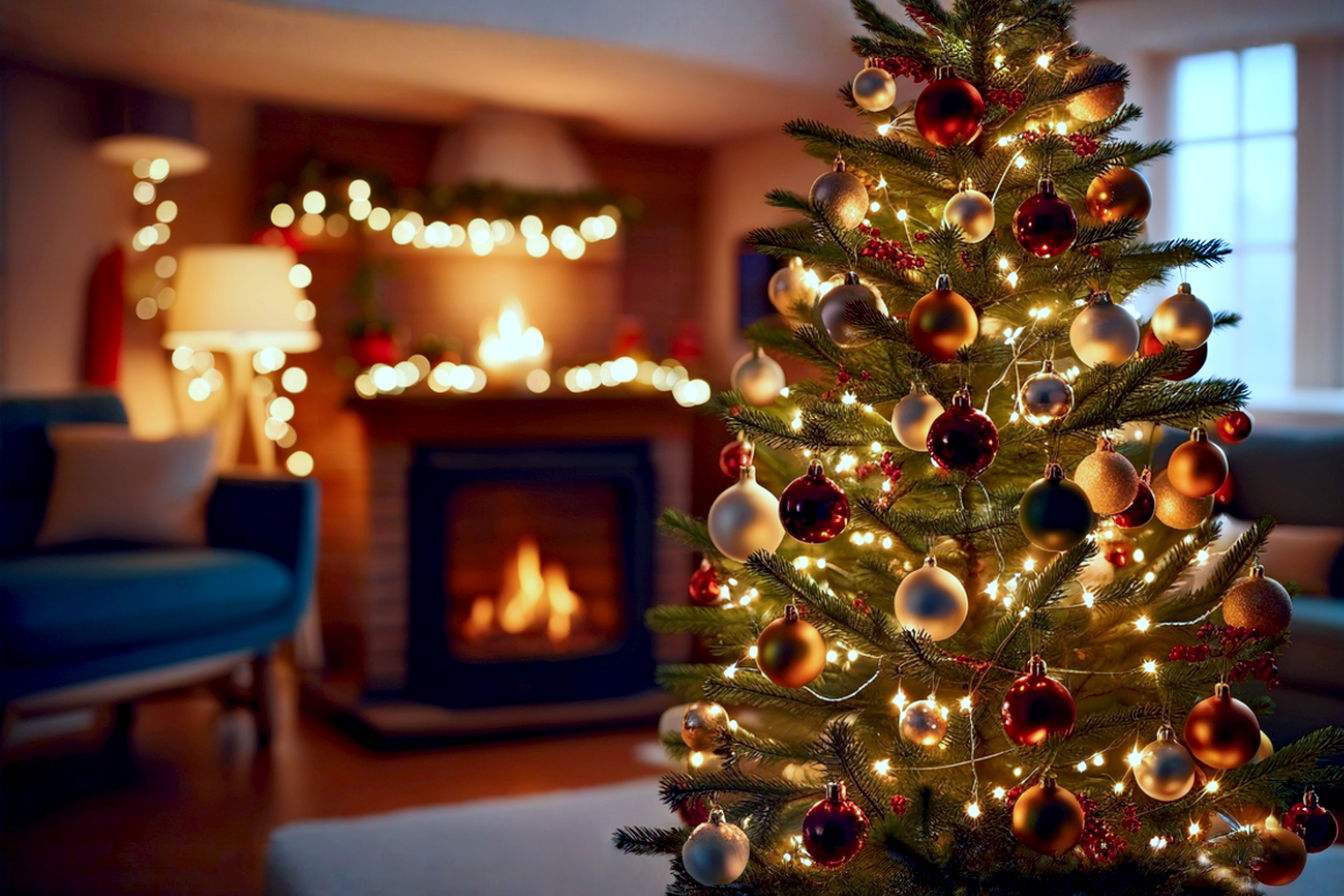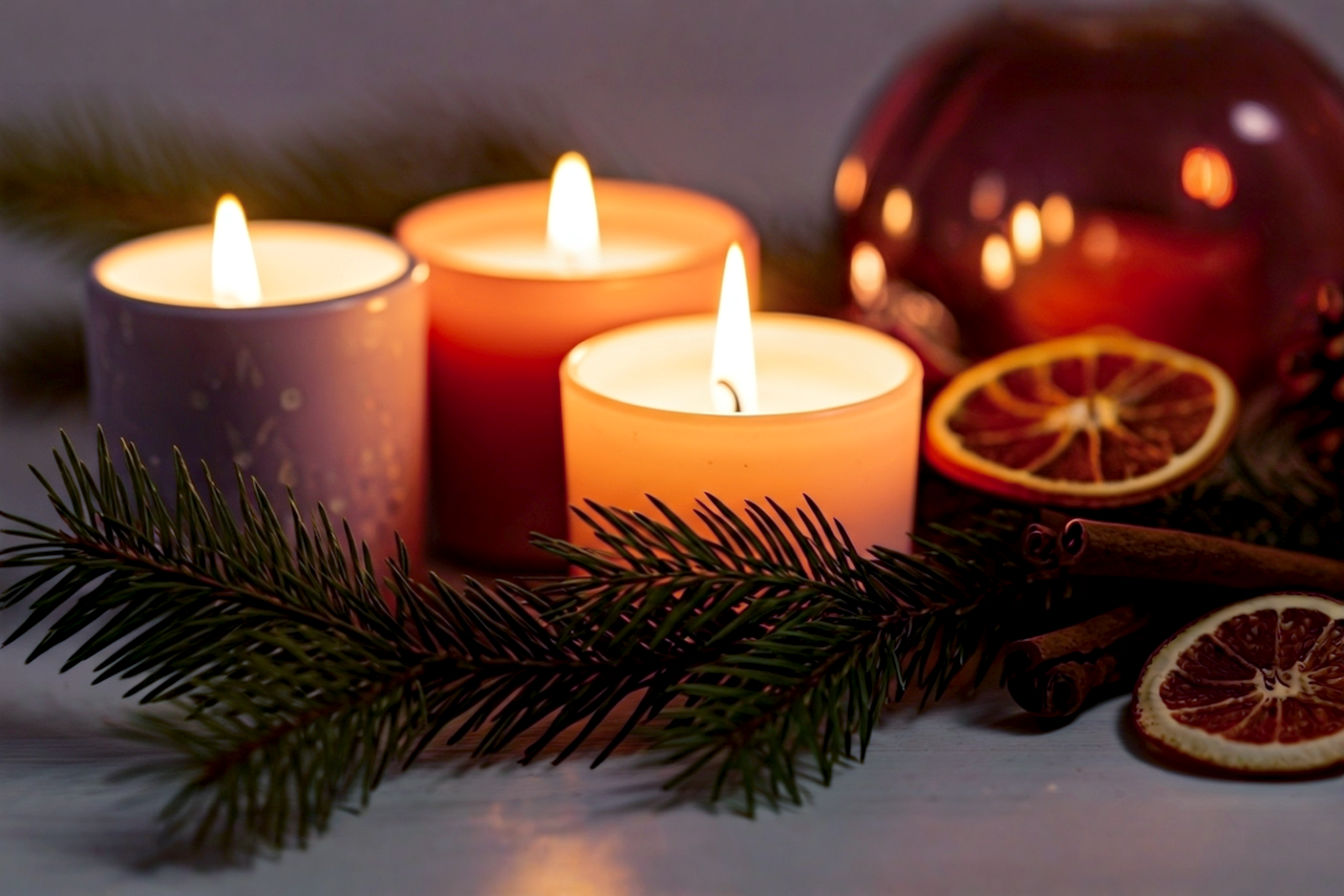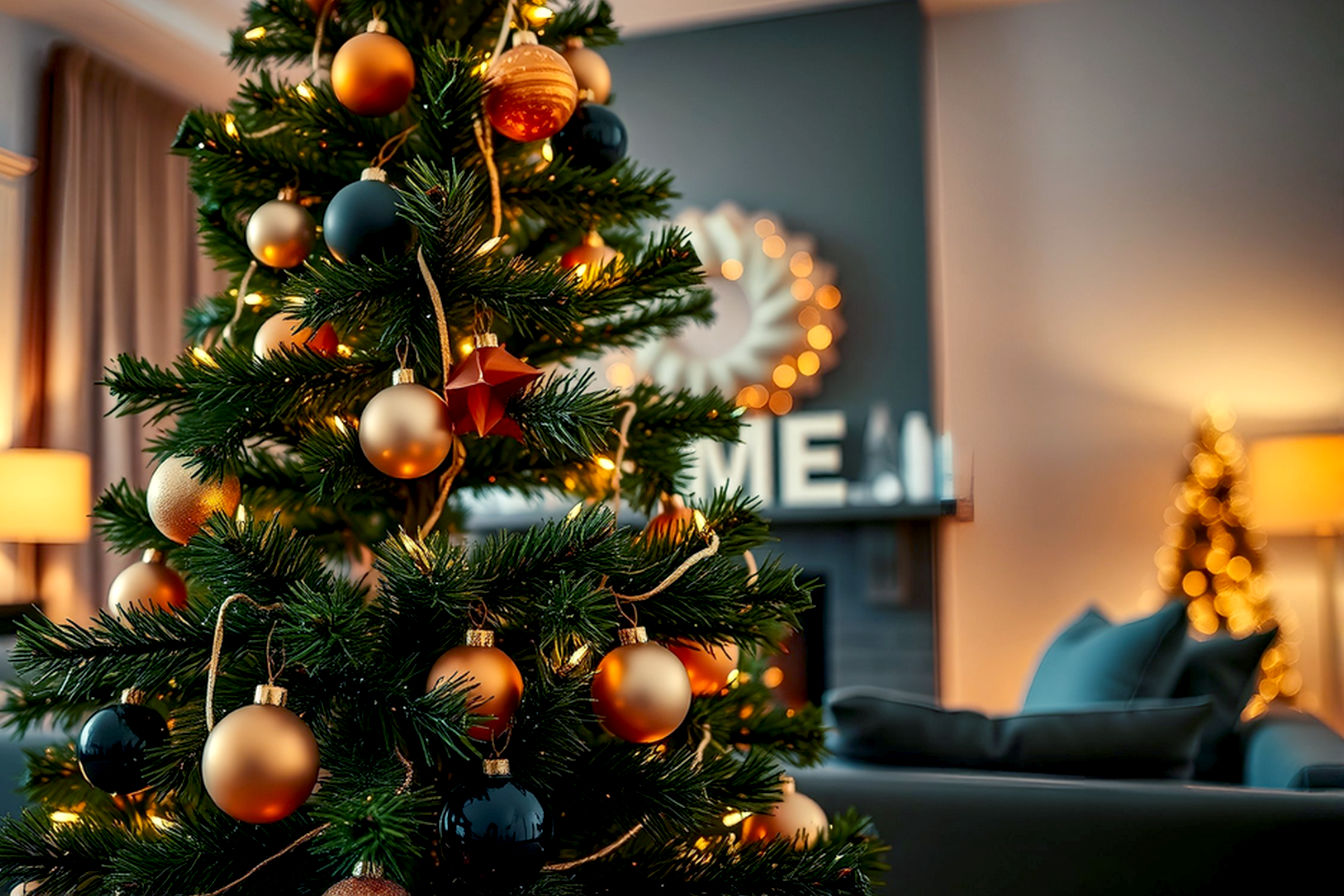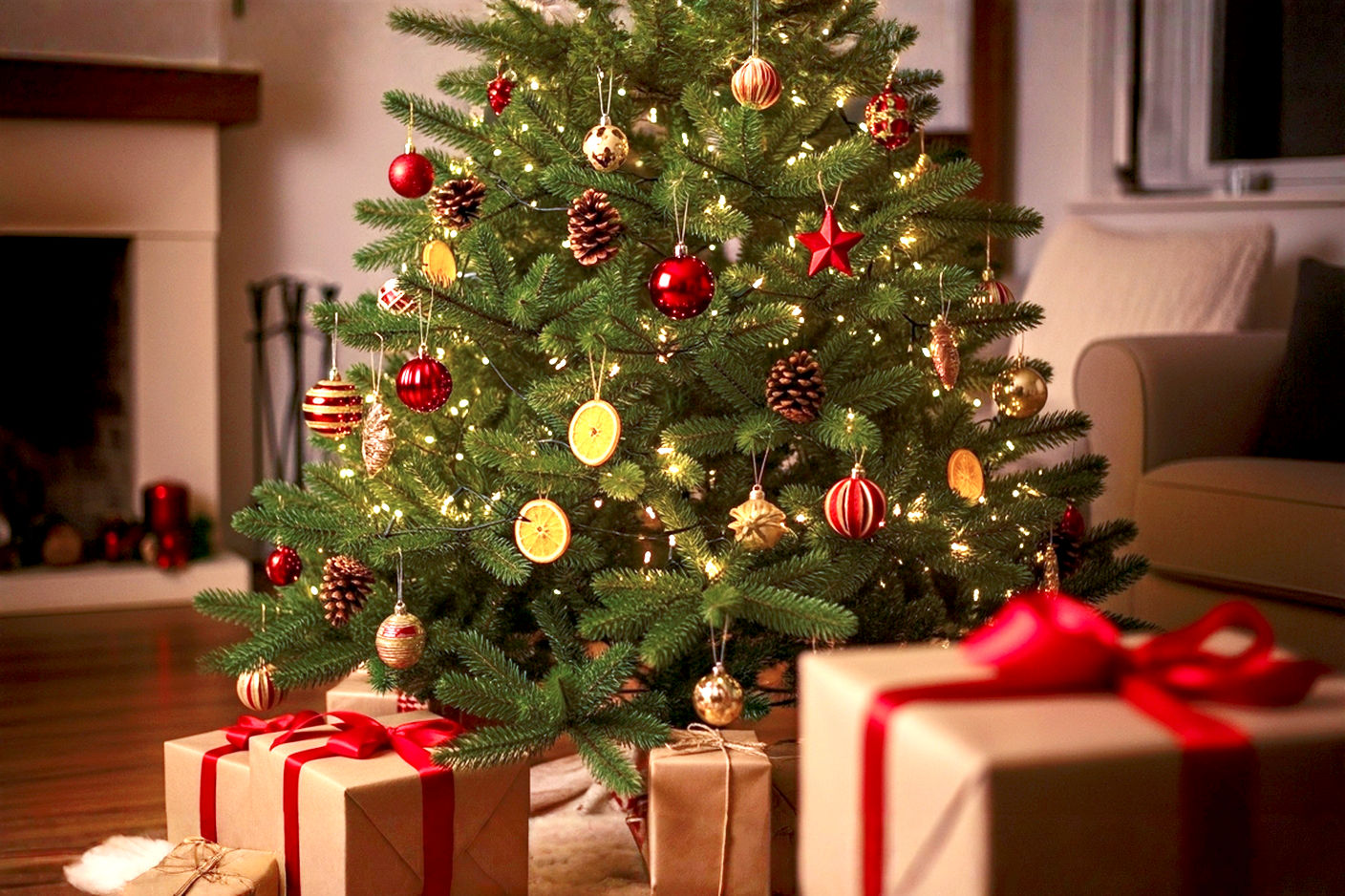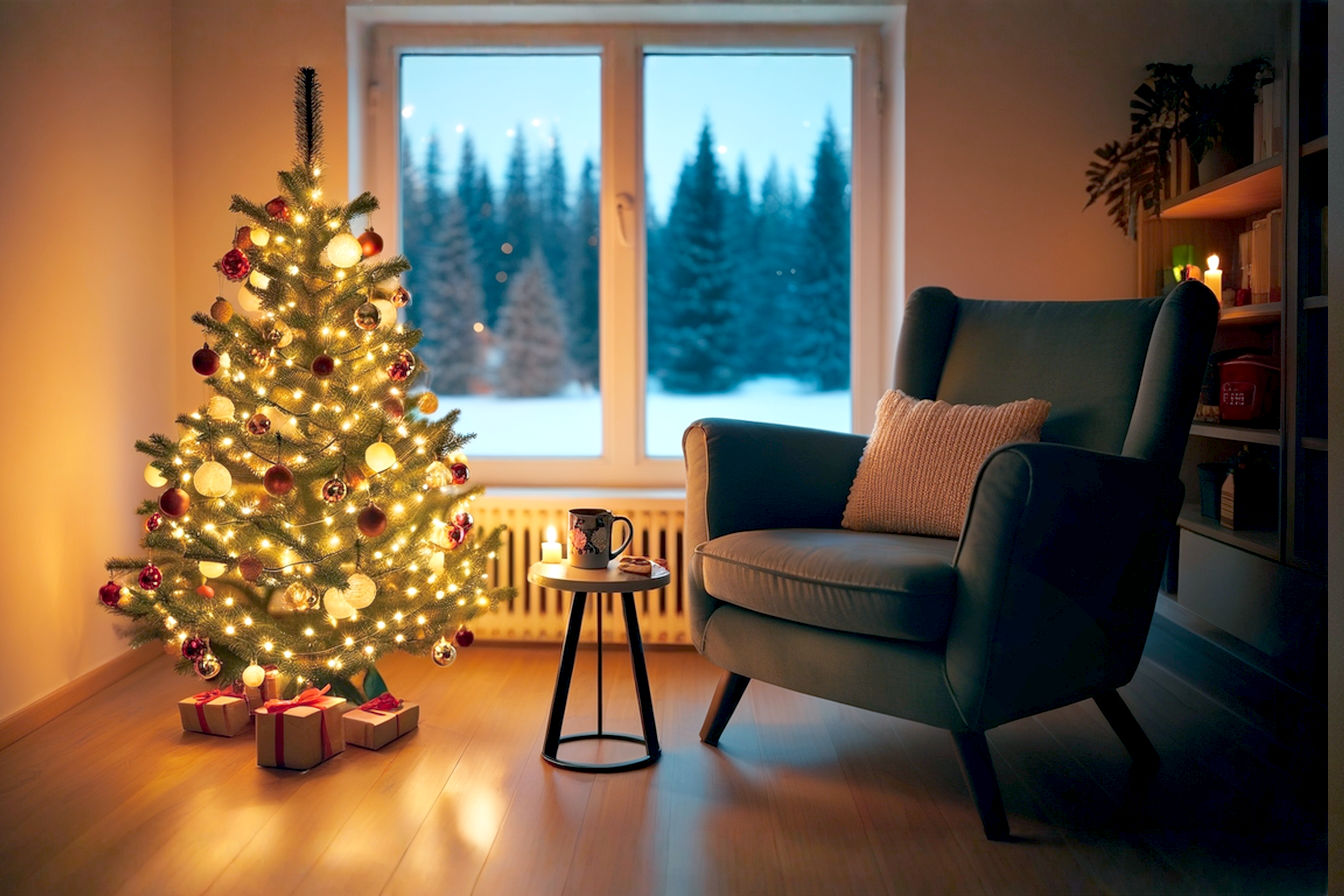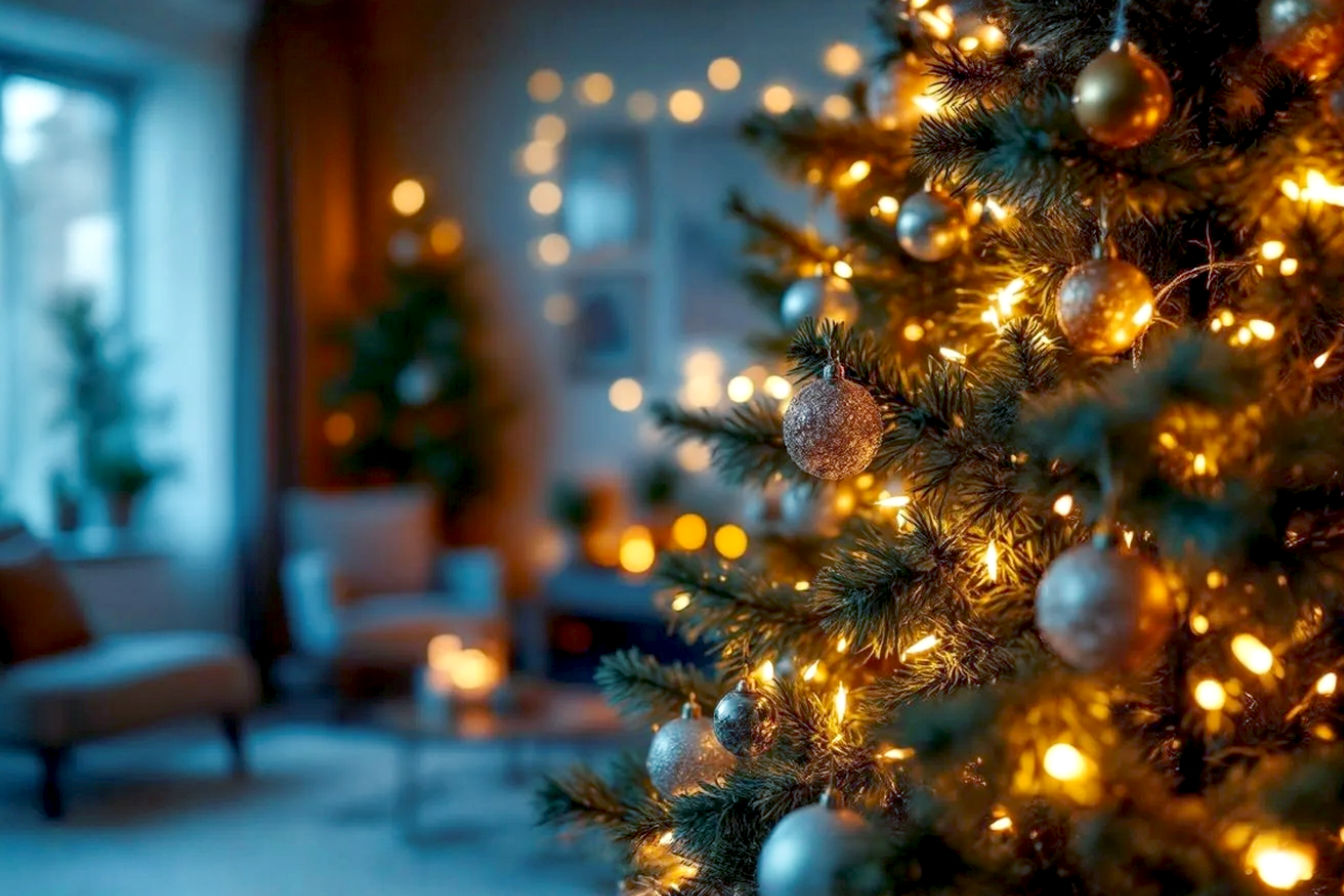This post may contain affiliate links. If you make a purchase through these links, we may earn a commission at no additional cost to you.
As the festive season approaches, many of us dream of a Christmas that feels both magical and deeply connected to the natural world. Imagine a tree adorned not just with glittering baubles, but with the quiet beauty of the forest itself. This isn’t just a trend; it’s a return to the roots of holiday decorating, embracing the simple, rustic elegance that nature offers. Woodland Christmas tree decorations bring a sense of calm and authenticity to your home, transforming your space into a cozy, enchanting retreat.
This guide will explore how you can infuse your holiday decor with the timeless appeal of the outdoors. We’ll dive into everything from responsibly gathering natural materials for Christmas to crafting beautiful, unique ornaments. You’ll learn how to create a cohesive woodland Christmas theme that extends beyond your tree, making your entire home feel like a winter forest wonderland. Get ready to discover the charm of nature-inspired Christmas decor and make this holiday truly special.
The Enduring Appeal of Woodland Christmas Decor
There’s something uniquely captivating about a Christmas tree dressed in elements from the forest. It goes beyond mere aesthetics; it taps into a deeper appreciation for simplicity and the environment. This natural Christmas ornaments trend isn’t just about looking good; it’s about feeling good, too.
Why do these natural themes resonate so strongly with us? For starters, they offer a connection to nature that many of us crave, especially during the colder months when we spend more time indoors. Bringing the outdoors in creates a serene and grounding atmosphere. It reminds us of crisp winter walks, the scent of pine, and the quiet beauty of a snow-dusted forest. This connection can reduce stress and promote a sense of well-being, making your home a true sanctuary during the busy holidays.
The shift towards sustainable Christmas decor also plays a significant role. In an age where environmental consciousness is growing, many people are looking for ways to celebrate without contributing to excessive waste. Opting for natural, reusable, or biodegradable decorations is a powerful statement. It’s about making mindful choices that benefit both your home and the planet. Unlike mass-produced plastic ornaments that often end up in landfills, natural decorations can be composted, returned to the earth, or stored for years, reducing your environmental footprint.
Furthermore, a rustic Christmas decor style evokes a powerful sense of nostalgia. It harks back to simpler times, perhaps to childhood memories of handmade ornaments or the charm of traditional, less commercialized holidays. This isn’t just about recreating a look; it’s about recapturing a feeling. The textures of wood, the earthy tones, and the organic shapes all contribute to a cozy, inviting atmosphere that feels genuinely authentic. It’s a comforting contrast to the often overwhelming commercialism of the holiday season, allowing for a more personal and meaningful celebration.
Foundational Elements: Setting the Woodland Scene
Creating an authentic woodland Christmas theme starts with the basics: your tree, its lighting, and your chosen color palette. These foundational elements will set the stage for all your beautiful, natural decorations.
Choosing Your Woodland Canvas: Real vs. Artificial Trees
The first decision is often about the tree itself. For a truly immersive woodland feel, a real Christmas tree is often preferred. Its natural scent, texture, and imperfect beauty are unmatched. Species like Fraser fir, Noble fir, or Balsam fir offer dense branches perfect for holding ornaments and a classic pine aroma that fills your home. If you choose a real tree, consider purchasing from a local, sustainable farm that practices responsible forestry. This supports local businesses and ensures your tree was grown with environmental care in mind.
However, if a real tree isn’t practical, a high-quality artificial tree can still provide an excellent base. Look for artificial trees with realistic-looking needles and a natural shape. Many modern artificial trees are designed to mimic the varying shades and textures of real evergreens, making them a convincing backdrop for your natural ornaments. You can even add pine-scented sticks or essential oil diffusers to bring in that authentic forest aroma. The advantage of an artificial tree is its reusability, which aligns with the sustainable aspect of woodland decor.
Illuminating the Forest: Warm, Subtle Lighting
When it comes to lighting your woodland tree, warm white Christmas lights are essential. Avoid bright, cool-toned LEDs or multi-colored lights, as they can detract from the natural aesthetic. Warm white lights cast a soft, inviting glow that mimics natural candlelight or moonlight filtering through the trees. They create a cozy, magical ambiance without overpowering your organic decorations.
Consider using smaller, more delicate fairy lights or micro-LED strands that can be woven deep into the branches, making the tree appear to glow from within. You can also layer different types of warm lights, such as traditional incandescent bulbs for a classic look combined with battery-operated micro-lights for added sparkle on specific branches or ornaments. The goal is to create a subtle, enchanting shimmer, not a blinding display.
The Earthy Palette: Colors of the Forest
The color palette for your woodland Christmas theme should draw directly from nature. Think about the colors you see in a winter forest: deep greens of pine needles, rich browns of tree bark and soil, soft creams and snowy whites, and muted reds from berries. These are your primary hues.
- Forest Greens: Use varying shades of green, from deep emerald to muted sage, reflecting different types of foliage.
- Earthy Browns: Incorporate browns through natural wood, pinecones, and rustic fabrics. These add warmth and grounding to the scheme.
- Snowy Whites and Creams: White elements, whether actual snow-dusted ornaments or white painted accents, evoke a fresh, wintry feel. Creams and off-whites add softness.
- Muted Reds: Think cranberries, holly berries, or dried rosehips. These provide natural pops of color without being overly vibrant or artificial.
- Subtle Metallics: A touch of gold, copper, or bronze can add a festive sparkle. These metallics should be used sparingly, perhaps on painted pinecone tips or subtle ribbon accents, mimicking the way sunlight catches natural elements. Avoid overly shiny or glittery finishes that might clash with the rustic feel.
By sticking to this natural palette, you’ll create a harmonious and inviting display that truly captures the essence of a serene winter woodland.
Foraging for Nature’s Treasures: A Responsible Guide
One of the most rewarding aspects of creating foraged Christmas decorations is the act of gathering the materials yourself. It’s an opportunity to connect with nature, enjoy the outdoors, and find unique elements that no store-bought ornament can replicate. However, it’s crucial to approach foraging with responsibility and respect for the environment.
Ethical Foraging Practices: Leave No Trace
Before you head out, remember that responsible foraging is key. This isn’t just about following rules; it’s about being a good steward of the natural world.
- Seek Permission: Always obtain permission before foraging on private property. If you’re on public land, check local regulations. Many parks and protected areas prohibit the removal of natural materials. A quick call to your local park service or land management office can clarify what’s allowed. Trespassing or taking from protected areas can lead to fines or harm ecosystems.
- Sustainability: Take Only What You Need: The golden rule of foraging is to take only a small amount from any single area. Never strip a plant bare or clear an entire patch. Think of it as harvesting, not plundering. For example, if you’re collecting pinecones, pick up fallen ones first. If you must take from a tree, choose a few from different branches rather than concentrating on one spot. This ensures that the plant can continue to thrive and provides resources for wildlife.
- Leave Enough for Wildlife: Remember that many natural elements you might want for decorations are food or habitat for animals. Berries, nuts, and seeds are vital food sources, especially in winter. Leave the majority for the birds, squirrels, and other creatures that depend on them. Your decorations should be a supplement to nature’s bounty, not a depletion of it.
- Avoid Protected Species: Learn to identify local plants, especially those that are rare, endangered, or protected. Never harvest from these species. Many regions have lists of protected flora, and it’s your responsibility to be informed. If you’re unsure about a plant, it’s always best to leave it undisturbed.
- Safety First: Be aware of your surroundings. Wear appropriate clothing to protect against thorns, ticks, and poison ivy (even in winter, dormant plants can cause irritation). Bring a field guide if you’re new to identifying plants. Carry a small pair of secateurs (pruning shears) for clean cuts, a basket or sturdy bag for collecting, and gloves. Avoid areas with heavy road traffic or industrial pollution, as materials from these areas may be contaminated.
What to Forage: Nature’s Bounty
With ethical practices in mind, here’s a list of fantastic natural materials for Christmas you can look for:
- Pinecones: These are perhaps the quintessential woodland decoration. Look for various sizes and shapes – large Ponderosa pinecones, smaller Scotch pinecones, or slender white pinecones. Different species offer unique textures and forms. Collect them after they’ve fallen and dried, as fresh, closed cones will open up as they dry indoors.
- Twigs and Branches: Search for interesting shapes, textures, and colors. Birch branches with their peeling white bark are particularly beautiful. Curly willow offers whimsical, twisted forms. Small, sturdy twigs can be used for crafting. Look for fallen branches after a windy day, or prune sparingly from your own property if you have suitable trees.
- Berries: Holly with its vibrant red berries is a classic. Hawthorn and rosehips also offer beautiful red and orange hues. Important Note: Many berries are toxic if ingested. If you have pets or small children, consider using artificial berries or placing real berries out of reach. For indoor use, ensure they are non-toxic if there’s any chance of contact.
- Leaves: Dried leaves in autumn colors (oaks, maples) can be pressed and used. Evergreen leaves like magnolia or rhododendron offer a glossy, sturdy texture. You can also find skeletal “ghost” leaves where the veins remain, creating a delicate, intricate look.
- Acorns, Seed Pods, and Dried Flowers: Acorns (with or without their caps), various seed pods (like milkweed or sweet gum balls), and dried flower heads (hydrangea, teasel) add incredible texture and interest. These often hold up well and can be collected after they’ve naturally dried on the plant or fallen to the ground.
By responsibly gathering these treasures, you’ll not only create stunning decorations but also deepen your connection to the natural world around you.
Crafting Woodland Wonders: DIY Ornament Ideas
Once you’ve gathered your natural treasures, the real fun begins: transforming them into beautiful DIY Christmas ornaments. This is where your creativity can truly shine, adding a personal, handmade touch to your homemade natural decor.
Pinecone Creations: From Simple to Sophisticated
Pinecones are incredibly versatile and can be used in countless ways. Before using them, make sure they are clean and dry. You can bake them on a low temperature (around 200∘F or 90∘C) for about 30 minutes to an hour to kill any bugs and help them open fully.
- Simple Dusted Pinecones: For an elegant “snow-dusted” effect, lightly brush the tips of pinecone scales with white craft paint or spray them with artificial snow. This creates a subtle, wintry look that complements the natural brown.
- Glittered/Painted Pinecones: For a touch of sparkle, apply a thin layer of craft glue to the tips of the scales and sprinkle with fine glitter in gold, silver, or iridescent white. You can also paint entire pinecones with metallic or matte earthy-toned paints for a more uniform look.
- Pinecone Animals: With a little felt, googly eyes, and glue, pinecones can be transformed into adorable woodland creatures like owls, squirrels, or hedgehogs. The pinecone forms the body, and felt pieces create wings, ears, or tails. This is a fun project for families.
- Pinecone Garlands: String smaller pinecones together using sturdy twine or fishing line. You can intersperse them with wooden beads, dried berries, or cinnamon sticks for added texture and fragrance.
Dried Citrus Slices: Aromatic and Beautiful
Dried orange slices are not only visually appealing with their translucent, stained-glass effect but also fill your home with a wonderful, natural citrus aroma.
- How to Dry Citrus:
- Slice oranges, lemons, or grapefruits thinly (about 1/4 inch or 0.6 cm thick).
- Pat them dry thoroughly with a paper towel to remove excess moisture.
- Arrange them in a single layer on a baking rack placed over a baking sheet.
- Bake in a very low oven, around 175∘F (80∘C), for 3-6 hours. The exact time depends on slice thickness and oven.
- Flip them occasionally. They are done when they are dry and firm, not sticky or squishy. They will become slightly translucent.
- Alternatively, use a food dehydrator following the manufacturer’s instructions.
- Uses: Once dried, poke a small hole at the top with a skewer or needle and thread with twine or ribbon for individual ornaments. They can also be strung into garlands with cranberries, cinnamon sticks, or bay leaves. They make beautiful additions to wreaths or bowl displays.
Cinnamon Stick & Spice Ornaments: Fragrance and Warmth
The warm, inviting scent of spices instantly evokes the holiday spirit. Cinnamon stick ornaments are easy to make and add both visual appeal and a delightful aroma.
- Bundled Cinnamon Sticks: Simply gather 3-5 cinnamon sticks, tie them together with rustic twine or a thin ribbon, and add a small sprig of evergreen or a dried orange slice. Hang them directly on the tree.
- Star Anise, Cloves, Dried Chillies: These spices can be individually tied with twine and hung, or incorporated into garlands and wreaths. Their unique shapes and colors add intriguing detail.
- Scented Dough Ornaments: Create salt dough or applesauce-cinnamon dough (recipes are widely available online). Roll out the dough, cut shapes with cookie cutters, poke a hole for hanging, and bake until hard. These can be painted or left natural, and they retain a lovely scent for weeks.
Twig & Branch Art: Rustic Simplicity
Simple twigs and branches can be transformed into charming, rustic decorations.
- Twig Stars and Snowflakes: Collect straight, thin twigs. Use hot glue or strong craft glue to assemble them into star or snowflake shapes. You can leave them natural, or paint them white, silver, or gold for a more festive look.
- Mini Trees: Bundle small evergreen sprigs or tiny twigs into miniature tree shapes, securing them with twine or floral wire. These can stand alone or be hung.
- Birch Bark Elements: If you find fallen birch bark (never peel it from a living tree), you can cut it into shapes like stars, hearts, or small houses and use them as unique, textured ornaments.
- Hanging Branches as Decor: A larger, sturdy branch can be hung horizontally from the ceiling (securely!) and decorated with lightweight ornaments, fairy lights, and greenery, serving as an alternative or supplementary display to your main tree.
Fabric & Felt Creations: Softness and Texture
Adding soft textures can create a cozy, inviting feel.
- Felt Woodland Animals: Felt is easy to cut and sew (or glue) into charming woodland creatures. Think simple silhouettes of deer, foxes, owls, or squirrels. Stuff them lightly for a plump effect, and add embroidered details.
- Burlap Ribbons and Twine Accents: Instead of traditional shiny ribbons, use natural burlap or jute twine to tie bows, create loops for hanging ornaments, or wrap around branches. These materials add a rustic, earthy touch.
- Fabric Scraps for Texture: Small pieces of plaid, wool, or linen fabric can be cut into strips and tied onto branches, or used to create small stuffed shapes.
Wood Slice Ornaments: Natural Canvas
Wood slice ornaments offer a beautiful, natural canvas for various artistic touches. You can buy pre-cut wood slices or cut your own from fallen branches (ensure they are fully dried to prevent cracking).
- Painted Designs: Use acrylic paints to draw simple designs like snowflakes, trees, or woodland animals. You can also paint a base color and then stencil on a design.
- Pyrography (Wood Burning): For those with a wood-burning tool, pyrography creates intricate, permanent designs that highlight the natural wood grain. This technique adds a truly artisanal touch.
- Natural Wood Grain Appeal: Sometimes, the beauty is in the simplicity. Just drill a small hole, thread a piece of twine, and let the natural wood grain speak for itself. You can seal them with a clear, non-toxic sealant to protect them.
Natural Bead & Nut Garlands: Timeless Traditions
These garlands bring a classic, homespun feel to your tree.
- Cranberry and Popcorn Garlands: A timeless tradition, stringing fresh cranberries and air-popped popcorn (unsalted, unbuttered) creates a beautiful, edible garland. Use a sturdy needle and strong thread or fishing line. These are temporary decorations, as they will dry out over time, but they offer a charming, old-fashioned appeal.
- Acorn/Nut Garlands: Drill small holes through dried acorns, chestnuts, or walnuts and string them together. You can leave them natural or paint them for added color.
- Wooden Bead Strings: Simple wooden beads, available at craft stores, can be strung into garlands. You can leave them natural, or paint them in your chosen earthy color palette.
By combining these crafting techniques, you’ll create a diverse and visually rich collection of DIY Christmas ornaments that perfectly embody the spirit of nature’s charm.
Integrating Wildlife: Forest Friends on Your Tree
No woodland Christmas theme is complete without the charming presence of forest creatures. These delightful additions bring life and a touch of whimsy to your tree, making it feel like a miniature forest ecosystem.
The charm of woodland creature ornaments lies in their ability to evoke a sense of wonder and connection to the wild. They remind us of the quiet inhabitants of the forest, adding personality and a narrative to your holiday display.
Types of Animal Ornaments: From Realistic to Whimsical
You can find or create a variety of animal ornaments to suit your style:
- Owls: With their wise eyes and soft feathers, owls are a popular choice. Look for ornaments made from felt, wood, or even real feathers (ethically sourced, of course).
- Foxes: The sly and beautiful fox, often depicted in rich russet tones, adds a splash of color and a touch of wildness.
- Deer: Elegant deer or reindeer, especially those with naturalistic textures or made from wood, fit perfectly into the rustic theme.
- Squirrels: Playful squirrels, perhaps clutching a tiny acorn, bring a sense of lively energy.
- Birds: Robins, cardinals, or small brown birds perched on branches add a delicate, natural touch.
- Mushrooms: While not animals, felt or wooden mushrooms are iconic woodland Christmas tree decorations and complement the animal theme beautifully. They add a touch of fairy-tale magic.
Materials and Placement for a Natural Look
When selecting or crafting these ornaments, consider materials that align with your overall nature-inspired Christmas decor:
- Felt: Soft and warm, felt is ideal for creating charming, handmade animal figures. You can easily cut, stitch, and stuff felt into various shapes.
- Wood: Carved wooden animals or flat wood slices with painted animal silhouettes offer a rustic, durable option. The natural grain of the wood enhances the organic feel.
- Glass: Frosted or subtly colored glass ornaments in animal shapes can add a touch of elegance and sparkle without being overly flashy.
- Plush/Fabric: Small, soft plush animals can be tucked into branches, adding a cozy, tactile element, especially appealing if you have children.
- Natural Elements: Some ornaments might incorporate real feathers (again, ethically sourced), tiny twigs, or miniature pinecones to create a more lifelike appearance.
Placement is key to making these creatures feel like they belong. Don’t just hang them evenly. Instead, imagine them peeking out from behind branches, nestled among clusters of pinecones, or perched on a bough. Create small “scenes” within your tree, as if these forest animals Christmas decor elements are truly inhabiting their woodland home. Vary their sizes and positions to create depth and visual interest. A larger deer ornament might sit near the base, while smaller birds perch higher up. This thoughtful arrangement will make your tree feel alive and enchanting.
Beyond the Tree: Extending the Woodland Theme Throughout Your Home
To truly immerse your home in the spirit of ‘Nature’s Charm,’ it’s important to extend your woodland Christmas decor ideas beyond just the tree. Consistency in your decorating scheme creates a harmonious and inviting atmosphere that flows throughout your living spaces.
Wreaths and Garlands: Welcoming Nature Indoors
Wreaths and garlands are excellent ways to bring the forest aesthetic to your doors, windows, and mantelpieces.
- Foraged Greenery Wreaths: Create stunning wreaths using fresh or preserved evergreen branches like pine, holly, eucalyptus, or cedar. You can use a wire wreath frame as a base and attach the greenery with floral wire. Embellish these with your handmade pinecones, dried orange slices, cinnamon sticks, or small bundles of red berries. A simple burlap bow or a few rustic bells can complete the look. These wreaths aren’t just for the front door; hang smaller ones on interior doors or above mirrors.
- Mantel Garlands with Lights and Natural Elements: Drape lush garlands along your mantelpiece. If using artificial garlands, choose high-quality ones that mimic real pine or spruce. Weave in warm white fairy lights to create a soft glow. Then, tuck in natural elements: larger pinecones, clusters of dried citrus, bundles of cinnamon sticks, and perhaps some faux or real red berries. You can also add small wooden animal figurines or frosted branches to enhance the rustic Christmas theme.
- Staircase Decor: Wrap garlands around your staircase banister, securing them with floral wire or zip ties. Add the same natural elements and lights as your mantel garland for a cohesive look. This creates a grand, festive entrance that immediately sets the woodland tone.
Table Settings and Centerpieces: A Feast for the Eyes
Your dining table offers another prime opportunity to showcase your natural home decor Christmas style.
- Pinecone and Candle Arrangements: A simple yet elegant centerpiece can be created by arranging various sizes of pinecones around pillar candles or votives in rustic holders (e.g., small logs or terracotta pots). Add sprigs of evergreen or a few dried cranberries for color.
- Greenery Runners: Instead of a traditional fabric runner, lay a “runner” of fresh or artificial evergreen branches down the center of your table. Intersperse it with small battery-operated fairy lights, acorns, and small wooden ornaments. This creates a natural, organic pathway for your dishes.
- Natural Place Settings: Tie napkins with twine or a thin strip of burlap, and tuck a small sprig of rosemary, a mini pinecone, or a dried orange slice under the knot. Use wooden charger plates or simple linen placemats to complement the rustic feel. Small, personalized wood slice ornaments can double as unique place cards.
Cozy Textiles: Warmth and Comfort
To truly capture the cozy essence of a woodland retreat, incorporate soft, natural textiles.
- Faux Fur Throws and Wool Blankets: Drape plush faux fur throws over sofas and armchairs, or fold chunky wool blankets at the foot of beds. These add incredible warmth, texture, and a touch of luxurious comfort, mimicking the soft fur of forest animals or the warmth of a cabin.
- Cushions with Woodland Motifs: Add throw cushions featuring subtle woodland motifs like embroidered trees, deer silhouettes, or plaid patterns in earthy tones. These small details reinforce the theme and make your seating areas more inviting.
Scent and Sound: Engaging All the Senses
Don’t forget the power of scent and sound to complete the immersive experience.
- Natural Scents: Enhance the atmosphere with natural scents that evoke the forest. Simmer pots with orange slices, cinnamon sticks, cloves, and pine needles on the stove. Use essential oil diffusers with pine, cedarwood, frankincense, or orange essential oils. Avoid artificial room sprays that can smell overpowering.
- Subtle Background Sounds: For a truly immersive experience, consider playing subtle background sounds of a winter forest – crackling fire, gentle wind through trees, distant bird calls. This is optional but can significantly enhance the tranquil ambiance.
By thoughtfully extending your woodland Christmas decor throughout your home, you’ll create a cohesive, enchanting, and deeply personal holiday environment that celebrates the beauty of nature.
Preserving Your Natural Decorations
While the ephemeral beauty of nature is part of its charm, you’ll likely want some of your DIY Christmas decor to last beyond a single season. Proper preservation techniques can extend the life of many natural elements, allowing you to enjoy them for years to come.
Drying and Curing Techniques
Many foraged items need to be properly dried or cured to prevent mold, decay, or insect infestation.
- Pinecones: As mentioned earlier, baking pinecones at a low temperature (200∘F or 90∘C) for 30-60 minutes helps to dry them thoroughly, open their scales, and kill any lingering insects. Let them cool completely before using.
- Dried Citrus Slices: The low-oven or dehydrator method ensures these are completely moisture-free, preventing mold. Once fully dried, they become hard and brittle.
- Berries: Fresh berries like holly can be strung or wired into arrangements, but they will eventually shrivel and darken. For longer-lasting berry accents, consider using artificial berries that mimic natural ones, or look for dried berries specifically treated for decor. Some crafters use a clear sealant spray on fresh berries to help them retain their color and shape for a bit longer, but this is not a permanent solution.
- Leaves: To preserve autumn leaves, you can press them between heavy books for a few weeks, or dip them in melted paraffin wax for a glossy, protective coating. Glycerin treatment (soaking leaves in a mixture of glycerin and water) can keep them pliable and prevent brittleness.
- Twigs and Branches: Most dried twigs and branches are naturally durable. Ensure they are clean and free of any lingering moisture or insects. You can spray them with a clear matte or satin sealant to protect them from dust and minor damage.
Anti-Transpirants for Greenery
Fresh evergreen cuttings, like those used in wreaths and garlands, tend to dry out quickly indoors due to warm, dry air. An anti-transpirant spray can significantly prolong their freshness.
- How it Works: Anti-transpirants are typically a waxy or polymer-based solution that forms a thin, clear coating on the plant’s surface. This coating reduces the rate of transpiration, which is the process by which plants lose water vapor through their leaves or needles. By minimizing water loss, the greenery stays hydrated and vibrant for a longer period.
- Application: After collecting your fresh greenery, allow it to hydrate by placing the cut ends in water for several hours or overnight. Then, lay the branches on a tarp or newspaper in a well-ventilated area and spray them thoroughly with the anti-transpirant, ensuring all surfaces are coated. Let them dry completely before arranging. Brands like Wilt-Pruf or Wilt Stop are commonly available at garden centers. This technique is especially useful for wreaths, garlands, and mantel decor that you want to keep fresh for several weeks.
Proper Storage for Reusability
For items you want to reuse year after year, proper storage is crucial.
- Dry and Clean: Ensure all natural decorations are completely dry and clean before storing. Any moisture can lead to mold, and dirt can attract pests.
- Airtight Containers: Store delicate items like dried citrus slices, felt ornaments, or wood slices in airtight containers or sealed plastic bags. This protects them from dust, humidity, and pests.
- Temperature and Humidity Control: Store them in a cool, dry place away from extreme temperature fluctuations. Attics and basements can sometimes be too humid or too hot, which can damage natural materials. A climate-controlled closet or spare room is ideal.
- Fragile Items: For very fragile items, like delicate twig stars, wrap them individually in tissue paper or bubble wrap and store them in boxes with plenty of padding to prevent breakage.
By taking these steps, you’ll ensure your DIY Christmas decor care is effective, allowing your beautiful preserving natural ornaments to bring joy for many Christmases to come.
Sustainability and the Woodland Christmas
Embracing woodland Christmas tree decorations isn’t just about aesthetics; it’s a conscious choice towards a more sustainable and mindful holiday season. This approach offers significant environmental benefits and encourages a shift away from disposable consumerism.
Environmental Benefits: Reducing Your Footprint
The core of a sustainable Christmas decorations philosophy lies in minimizing environmental impact.
- Reduced Waste: Traditional Christmas decorations, especially those made from plastic, often have a short lifespan and contribute significantly to landfill waste. By contrast, natural materials like pinecones, twigs, and dried fruits are biodegradable. When the season is over, most of these elements can be composted or returned to the earth, completing their natural cycle. Even if you use some purchased items, choosing those made from wood, paper, or natural fibers drastically reduces plastic waste.
- Lower Carbon Footprint: Manufacturing and transporting mass-produced ornaments consume considerable energy and resources. Foraging for your own materials, or purchasing locally sourced natural items, drastically reduces the carbon footprint associated with your decorations. It minimizes the need for long-distance shipping and energy-intensive production processes.
- Support for Local Ecosystems (with responsible foraging): When done ethically, foraging can foster a deeper connection to local ecosystems. It encourages people to learn about their local flora and fauna, promoting respect and stewardship for natural spaces. It’s a gentle interaction that, when practiced responsibly, doesn’t harm the environment but rather enhances appreciation for it.
A Mindful Approach to the Holidays
Beyond the tangible environmental benefits, an eco-friendly Christmas tree and home decor promote a more mindful approach to the holidays.
- Embracing Reusability: Many natural decorations, especially those that are dried and preserved, can be reused year after year. Wood slices, durable pinecones, and well-preserved branches become cherished family heirlooms, reducing the need to buy new items annually. This reusability is a cornerstone of sustainable living.
- Fostering Creativity and Connection: The process of gathering and crafting natural decorations encourages creativity and often becomes a cherished family activity. It shifts the focus from commercial consumption to hands-on creation and shared experiences. This deeper engagement with the holiday preparations can make the season more meaningful and less about material possessions.
- Promoting Simplicity and Authenticity: A woodland theme naturally leans towards simplicity and authenticity. It reminds us that beauty doesn’t have to be elaborate or expensive. The inherent elegance of natural forms, textures, and scents is often more impactful than artificial glitter and plastic. This encourages a holiday celebration that is grounded, genuine, and less reliant on commercial pressures.
Choosing sustainable Christmas decorations is more than just a decorating choice; it’s a lifestyle choice. It’s about celebrating the holidays in a way that honors the planet, fosters creativity, and brings a deeper sense of peace and connection to your home. It’s a beautiful way to ensure that your festive joy doesn’t come at the Earth’s expense.
Conclusion
Embracing ‘Nature’s Charm’ for your Christmas tree and home decor is a truly rewarding experience. It’s a way to step back from the commercial hustle and reconnect with the simple, profound beauty of the natural world. By choosing woodland Christmas tree decorations, you’re not just creating a stunning visual display; you’re cultivating a cozy, inviting atmosphere that resonates with warmth, authenticity, and peace.
From the quiet joy of foraging for unique treasures to the satisfaction of crafting your own DIY Christmas ornaments, every step in this process deepens your connection to the holiday spirit. You’ll find that the earthy tones, the natural textures, and the subtle scents of pine, cinnamon, and dried citrus create an ambiance that is both elegant and deeply comforting.
Moreover, opting for nature-inspired Christmas decor is a powerful statement about sustainability. It’s about making conscious choices that reduce waste, minimize your carbon footprint, and honor the environment. This mindful approach to decorating allows you to celebrate the season with a clear conscience, knowing that your festive cheer is also contributing to a healthier planet.
So, this holiday season, let the forest be your muse. Gather your pinecones, dry your citrus, and weave in the magic of woodland creatures. Transform your home into a serene winter wonderland, filled with the timeless charm of nature. You’ll discover that the most beautiful decorations are often those that come directly from the heart of the wild.

